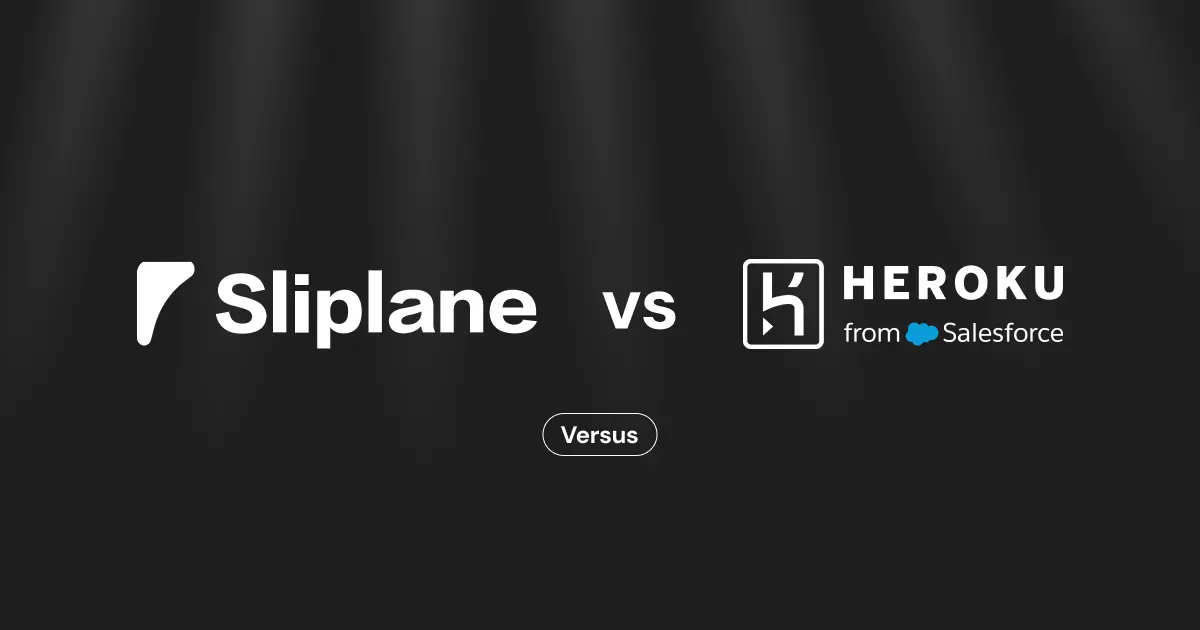
Sliplane vs. Heroku
 Jonas Scholz
Jonas ScholzSliplane takes a radically different approach to container hosting. Instead of Heroku's complex per-dyno pricing from 2010, you rent a server and run as many containers as it can handle for one fixed monthly price.
How It Works
Here's the simple concept: You rent a server (starting at 2 vCPUs / 2GB RAM for €9/month), and you can run as many containers as it can handle.
Want to host:
- A frontend app
- A backend API
- A PostgreSQL database
- An n8n automation workflow
- A Redis cache
- A monitoring service
All on one €9/month server? Go for it. Your cost stays the same whether you run 1 container or 20.
The Heroku Problem: Outdated and Overpriced
Let's be honest - Heroku feels stuck in 2010. Since Salesforce acquired them, innovation has stagnated while prices have soared:
The pricing nightmare:
- Basic dyno: $5-7/month (sleeps after 30 min of inactivity)
- Standard dyno: $25-50/month per dyno
- Performance dynos: $250-500/month
- Each add-on (database, Redis, etc.) costs extra
- Zero innovation since 2018
Real costs:
- Running a simple web app 24/7: $25/month minimum
- Add a database: +$15/month for basic Postgres
- Need Redis? +$15/month more
- Want to run 3 apps? That's $75/month just for the dynos
Meanwhile, Heroku still doesn't support:
- Docker Compose natively
- Modern deployment workflows
- Proper multi-container applications
- Competitive pricing for 2025
One-Click Open Source Deployments
Both platforms let you deploy open source tools, but the experience is night and day:
Heroku:
- Limited marketplace with outdated "buttons"
- Each app needs its own dyno ($$$)
- Many popular tools don't even work due to Heroku's restrictions
- Stuck with buildpacks from 2015
Sliplane:
- Modern presets for popular tools (n8n, databases, AI tools)
- One-click deployment with zero additional cost
- Full Docker support - if it runs in Docker, it runs on Sliplane
- Deploy as many tools as your server can handle
Here is a demo showing how you can deploy n8n in less than 1 minute:
When Heroku (Still) Makes Sense
To be fair, Heroku isn't completely obsolete:
- Legacy Rails apps that were built specifically for Heroku
- Enterprise teams already locked into Salesforce ecosystem
- Projects where you don't mind paying 10x for convenience
- Developers who haven't updated their deployment knowledge since 2015
But honestly? In 2025, these are edge cases. Most developers have moved on to modern alternatives.
Real-World Example: Running a SaaS Application
Let's say you're building a typical SaaS that needs:
- A Next.js frontend
- A Node.js API
- A PostgreSQL database
- A Redis cache for sessions
- Background job processing with Bull
- Monitoring with Grafana
On Heroku:
- Frontend dyno: $25/month
- API dyno: $25/month
- Postgres: $15/month (hobby tier)
- Redis: $15/month
- Worker dyno: $25/month
- Monitoring: Not available (need external service)
- Total: $105/month minimum
On Sliplane:
- All services on one server
- Fixed monthly cost: €24 (Medium server)
- Including monitoring, logging, and metrics
- Total: €24/month (~$26)
The difference? Heroku costs you 4x more for inferior service.
The Bottom Line
Heroku was revolutionary in 2010. But it's 2025, and they're still charging premium prices for technology that hasn't evolved in years. If you're still on Heroku, you're literally paying for Salesforce's acquisition costs.
Sliplane gives you modern deployment tools, predictable pricing, and the freedom to run whatever you want - all for less than the cost of a single Heroku dyno.
Tired of Heroku's pricing? Join hundreds of companies who've already made the switch. Your wallet will thank you.
Cheers,
Jonas, Co-Founder of sliplane.io